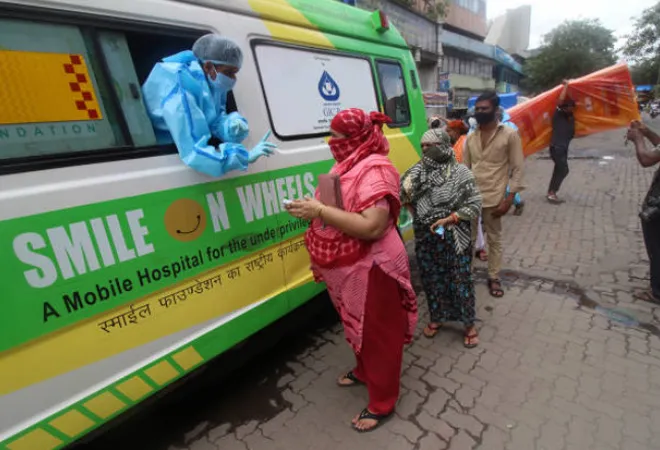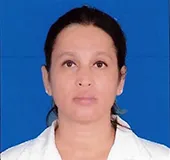 This article is part of the series Colaba Edit 2021.
This article is part of the series Colaba Edit 2021.
In the aftermath of the July 2005 deluge, numerous photos emerged of stranded people wading through Mumbai’s flooded streets as the transportation system broke down. There was a spike in leptospirosis cases as citizens were forced to wade through waters contaminated with animal urine, which in turn transmitted the bacteria from animals to humans. Soon, over three lakh patients needed treatment for leptospirosis and other water-borne diseases.
While leptospirosis requires early diagnosis and treatment to reduce the risk of mortality, the city’s lack of preparedness was exposed as all blood samples had to be sent to the National Institute of Virology, Pune, to test for leptospirosis and to the ICMR-Regional Medical Research Centre, Port Blair, for a confirmatory test. Notably, the Brihanmumbai Municipal Corporation (BMC), India’s richest municipal body, did not have a molecular diagnostic laboratory and citizens had to wait over two weeks for an actual confirmation of leptospirosis.
On the direction of then Shiv Sena president and current Maharashtra Chief Minister Uddhav Thackeray, the BMC sanctioned INR 4 crore (US$0.9 million at 2006 conversion rates) in its 2006 budget to set up the molecular diagnostic laboratory at the Kasturba Hospital for Infectious Diseases. This simple wisdom of establishing a critical missing infrastructure has, in hindsight, proved to be visionary.
The Brihanmumbai Municipal Corporation (BMC), India’s richest municipal body, did not have a molecular diagnostic laboratory and citizens had to wait over two weeks for an actual confirmation of leptospirosis.
Building Decentralised Capacity
The molecular laboratory (both equipment and human resources) played a critical and central role during the COVID19 pandemic in diagnosing and confirming cases and new virus strains quickly, helping the BMC formulate its strategy to contain the spread of the virus and save lives. It was the first Covid testing centre in Mumbai, and was used to perform validation for Covid test kits. The experience of setting up and operating the laboratory, helped the BMC to quickly establish and operationalise dedicated laboratories for RT-PCR testing at other civic hospitals (Sion, Cooper and Nair Hospitals) and later add one in each of the western and central suburbs (HBT Traumacare – Jogeshwari, Rajawadi Hospital). Private players were also invited to build testing capacities and there are now over 45 RT-PCR labs in Mumbai across the BMC, state government, ICMR and private sector.
The Mumbai floods triggered another significant contribution to the city’s ability to combat disaster, one that has served it well during the pandemic—the setting up of the Disaster Control Room at the BMC headquarters, linked to Mantralaya, the Mumbai Police headquarters and the Traffic Police control room. During COVID-19, the control room model was replicated in each ward, termed as war rooms and manned by young doctors. The war rooms were tasked with overseeing and managing the allocation of hospital beds, arranging ambulances to ferry patients to isolation centres and hospitals, provide information and counselling to citizens, and follow up with patients who were home-quarantined.
The city required a rapid ramp-up of capacities to manage and control the pandemic. The BMC set up five jumbo centres across the city in response to the first wave to rapidly increase the number of beds, and provide intensive care and testing facilities. These doubled up as vaccination centres from January 2021, post the launch of the COVID-19 vaccination drive. Top specialist doctors from private hospitals were tasked with overseeing the treatment at these jumbo centres, even as other young doctors and medical staff were recruited. The BMC also commandeered 80 percent of beds in private hospitals to boost its treatment and care capacity. Additionally, the BMC identified several hotels as isolation centres for travellers arriving from foreign countries, and later, in the second wave, as stepdown facilities for non-critical patients occupying hospital beds.
With the onset of the second wave, when an acute shortage of oxygen supply was seen around the country, the BMC approved the setting up of 16 liquid medical oxygen plants at 12 locations with a cumulative capacity of 45 metric tonnes per day. These plants have been built and commissioned, increasing the daily oxygen production capacity from 3.3 metric tonnes (two plants) to approximately 45 metric tonnes.
The BMC set up five jumbo centres across the city in response to the first wave to rapidly increase the number of beds, and provide intensive care and testing facilities.
The BMC’s handling of the crisis in Dharavi, a highly congested slum area, also emerged a success story. The BMC’s ward office for the area (G/North) ensured public toilets, identified as the most common point of contact and spread of the virus, were sanitised multiple times, and worked with elected representatives and community leaders to provide food to residents who lost their jobs and income. The Dharavi model of aggressive tracking and testing was acknowledged by the World Health Organization.
However, despite these successes, the lockdown and mass migration of people chiefly from the slum areas exposed the lack of decent housing for all and open spaces. The pandemic also highlighted others gaps in preparedness, such as when authorities distributed dry ration instead of cooked meals even as people struggled to afford cooking fuel and other essentials. Amid such a situation, civil society organisations had to provide such support.
While the BMC managed to get a grip on the pandemic to an extent, the neighbouring municipal corporations in Thane and Navi Mumbai struggled to provide medical care. The BMC’s comparative success in managing the crisis was commended by the Bombay High Court, which directed its replication in neighbouring municipal areas. The BMC’s successful management of oxygen supplies was lauded by the Supreme Court, which asked the Centre and the Delhi government to learn from the city.
Learnings
Although the BMC’s financial prowess is a huge bonus for Mumbai, the civic administration and political dispensation have failed in creating a vision and harnessing this strength to create a liveable city that offers a decent quality of life. The Mumbai development plan, prepared every 20 years, must be revisited every few years so that it is in line with the city’s changing requirements, especially in light of increased incidents of natural and man-made calamities.
Mumbai’s health infrastructure may be the best in the country but as challenges grow, the BMC must invest in human capital to create public health leadership, including epidemiologists, microbiologists, biotechnologists, and zoonotic experts. Primary health centres must be developed not just for surveillance, but to function as early warning systems in the likelihood of repeated viral outbreaks. The BMC, and indeed other cities with congested spaces, must consider adopting Delhi’s mohalla (community) clinic model for its densely populated areas. Additionally, legislation must be introduced to curb prices at private hospitals and also empower the BMC to monitor these charges. Upgrades to medical infrastructure (doctors, testing facilities, and equipment) in suburban Mumbai will be beneficial to the entire Mumbai Metropolitan Region (including neighbouring Thane and Navi Mumbai).
Primary health centres must be developed not just for surveillance, but to function as early warning systems in the likelihood of repeated viral outbreaks.
There are already some efforts being made on this front. The heads of departments at the major civic hospitals in the city have now been asked to draw up five-year plans with fund allocation, including setting aside funds for technology upgrade. The BMC has added a genome sequencing lab at Kasturba Hospital, and an immunology and clinical skills lab at Nair Hospital.
The COVID-19 pandemic has also placed renewed focus on proper housing and open spaces to enable sanitary conditions, proper social distancing and quality of life. The Slum Rehabilitation Scheme has failed to create decent urban housing, leading to further slumification of the city. Affordable housing must, therefore, replace the concept of free housing, a cost the city can ill afford.
Lessons for the World
With 45.2 percent of Maharashtra’s population living in urban and semi-urban areas, the state government must learn from the successes of the Mumbai model and the critical gaps identified to decentralise decision-making, focus on primary healthcare centres and prepare development plans with proper outcomes.
The same lesson holds good for all urban areas in India and across the world. Cities across the world must leverage their financial muscle to rapidly boost capacities in times of need. The Dharavi model specifically has lessons for cities in the Global South that have large highly congested slum sprawls, such as Brazil’s Rio de Janeiro and South Africa’s Cape Town.
The views expressed above belong to the author(s). ORF research and analyses now available on Telegram! Click here to access our curated content — blogs, longforms and interviews.



 This article is part of the series
This article is part of the series  PREV
PREV


